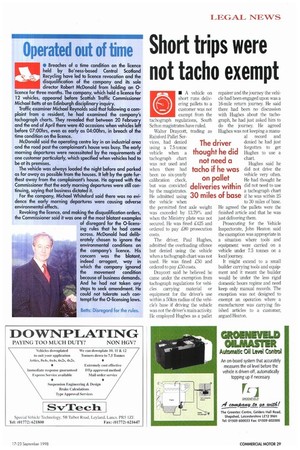Short trips were not tack exempt
Page 31

If you've noticed an error in this article please click here to report it so we can fix it.
• A vehicle on short runs delivering pallets to a customer was not exempt from the tachograph regulations, South Sefton magistrates have ruled.
Walter Draycott, trading as Rainford Pallet Services, had denied using a 7.5-tonne vehicle when a tachograph chart was not used and when there had been no six-yearly calibration check, but was convicted by the magistrates. He admitted using the vehicle when the permitted first axle weight was exceeded by 13.79% and when the Ministry plate was not secured. He was fined £425 and ordered to pay £80 prosecution costs.
The driver, Paul Hughes, admitted the overloading offence but denied using the vehicle when a tachograph chart was not used. He was fined £50 and ordered to pay £50 costs.
Draycott said he believed he came under the exemption from tachograph regulations for vehicles carrying material or equipment for the driver's use within a 50km radius of the vehicle's base if driving the vehicle was not the driver's main activity. He employed Hughes as a pallet repairer and the journey the vehicle had been engaged upon was a 16-mile return journey. He said there had been no discussion with Hughes about the tachograph, he had just asked him to do the journey. He agreed Hughes was not keeping a manual record and denied he had just forgotten to get Hughes to use a chart.
Hughes said he did not drive the vehicle very often. He had thought he did not need to use a tachograph chart if he was within 25 to 30 miles of base. He agreed the pallets were the finished article and that he was just delivering them.
Prosecuting for the Vehicle Inspectorate, John Heaton said the exemption was appropriate in a situation where tools and equipment were carried on a vehicle under 7,5 tonnes on a local journey It might extend to a small builder carrying tools and equipment and it meant the builder would be under the less rigid domestic hours regime and need keep only manual records. The exception was not designed to exempt an operation where a manufacturer was carrying finished articles to a customer, argued Heaton.




























































































































